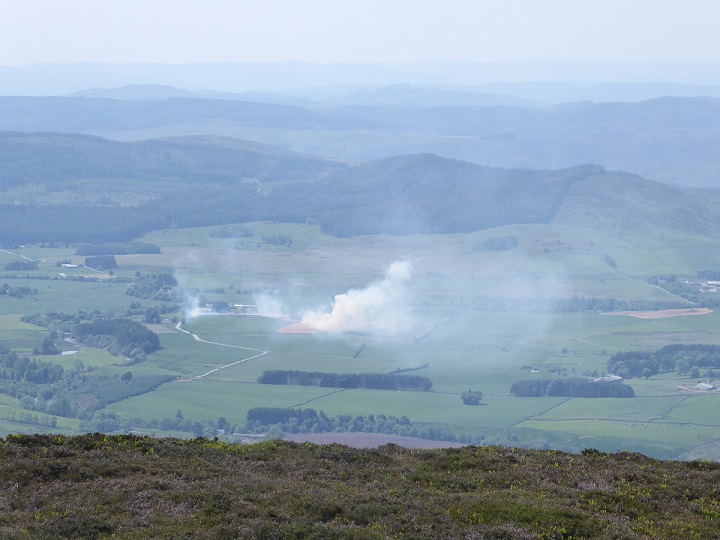
Yesterday afternoon, after my post (see here) on Forest and Land Scotland (FLS)’s responsibility for the fires in Glenmore, the Cairngorms National Park Authority (CNPA) issued a news statement (see here) about how they were responding (to the fires, not my post).
On the negative side, the statement contains not a mention of FLS and re-iterates the commitment the CNPA made in its National Park Partnership Plan to produce an “Integrated wildfire management plan” without any mention of whether it intends to bring the date for the plan forward. The plan is due in 2027 and unless that changes Forest and Land Scotland will be able to ignore their responsibilities for another four years.
On the positive side the statement says the CNPA’s rangers (again no mention of FLS rangers) will be doing joint patrols with the police “who have wider powers of enforcement that could be used if necessary”. That is absolutely what needs to happen, the answer to these problems as I argued in my last post lies in applying the criminal law and it is positive to see Police Scotland appear to have recognised their responsibilities (unlike Forest and Land Scotland). It is also positive there is no mention of camping byelaws but rather “fire management byelaws”. This is a welcome recognition of the fact that , as I explained in my last post, “fires” and “camping” are distinct issues.
The CNPA’s position on visitors lighting fires has been evolving fairly rapidly over the last three years. In the draft version of the the current National Park Partnership Plan (NPPP) in 2021 the CNPA had proposed a policy of:
“Implementing a ‘no open fires or barbecues outside private garden ground’ policy between April and October”
It then rightly pulled back from that to a position, which was contrary to access rights, to one more in accord with the Scottish Outdoor Access Code:
“Reducing fire risk by limiting or excluding barbecues and open fires in key areas of the National Park, such as in areas of woodland and peatland”
Now the emphasis, as reported in their statement, is on:
“‘no camp fires’ and ‘no disposable barbecues’ messaging during times of high fire risk”.
In my opinion, this basically gets it right: it is not sensible that anyone light open fires of whatever type (not just campfires but garden fires, stubble fires etc etc) or use barbecues outside of fire pits during very dry spells – although policy on this, I believe, should be driven by the expertise of the Scottish Fire and Rescue Service.
Enshrining a no campfires or disposable barbecues message in fire management byelaws, as the CNPA Board have now asked their staff to consider, may or may not make sense and make a difference from a fire prevention perspective. However, to the extent that it might help make a difference, to do so without including the other causes of wildfires is completely discriminatory.
On 12th June I was on the National Trust for Scotland’s Mar Lodge Estate and heard how the fire brigade had been called out the previous night, thanks to a concerned hillwalker, to put out a large campfire up at Derry Lodge (four miles from the end of the public road). Lighting that fire in those conditions and in that place was absolute madness but two days later, on my way home, I ran up to the summit of Mount Blair – a wonderful viewpoint – to witness the scene in the photo above. It is outside of the National Park but shows that land managers can be just as irresponsible when it comes to fires as visitors.
The CNPA Board need to recognise that and commit to the principle that if they find byelaws are an appropriate means of reducing fire risk, those rules and measures should apply to all. They would do well to recall that the most damaging forest fire that has occurred in the National Park in the last few years was in Glen Tanar in 2018 and caused by the landowner, Michael Bruce, a self professed fire expert (see here).

I was with Nick on the visit to Mar Lodge on 12 June. When the fire brigade was called out to deal with a reckless camp fire on the previous evening the NTS reserve manager, who lives locally, was on hand to help coordinate action. Compare this to Glenmore Forest Park where, according to the Cairngorms National Park Board meeting last week, the nearest senior manager for Forestry and Land Scotland is located north of Inverness. This is absurd and requires Scottish ministers to ask FLS what on earth they are playing at.
As a former firefighter who has attended field, muir, and woodland fires I can categorically state that most were caused by the landowners themselves (not always deliberate) or their employees/contractors. I’ve attended combine harvesters that have gone up in flames and then burned the remaining crop; woodland contractors using heavy machinery and fuel that has ignited; deliberate “muirburn” by gamekeepers that has simply got out of control because the wind has got up and/or changed direction. Of course there is always the deliberate arson attacks on landowners – a bale fire near me recently burned 1000 bales stacked in a field. So it is not always the public to blame and the Fire Officer at Glenmore was far too quick to blame the public when he presented no evidence at all when on live tv camera. I am yet to see categorical evidence being presented. Yes the public MUST be vigilant and adhere to advice when there is serious risk but so must the landowners/Authorities themselves.